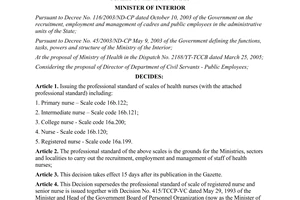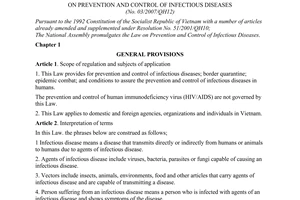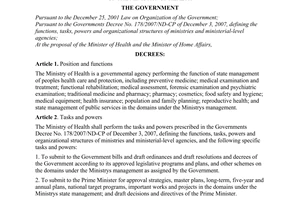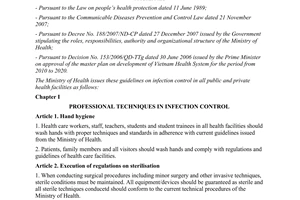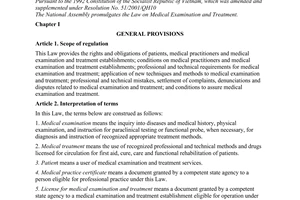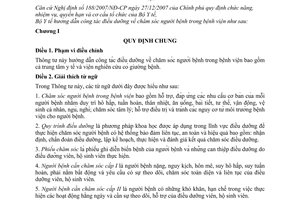Nội dung toàn văn Circular No. 07/2011/TT-BYT guiding the nursing in hospitals
|
THE MINISTRY
OF HEALTH |
SOCIALIST
REPUBLIC OF VIET NAM |
|
No: 07/2011/TT-BYT |
Hanoi, January 26, 2011 |
CIRCULAR
GUIDING THE NURSING IN HOSPITALS
Pursuant to the Government’s Decree No. 188/2007/ND-CP dated 27/12/2007, defining the functions, tasks, powers and organizational structure of the Ministry of Health,
The Ministry of Health guides the nursing in hospitals as follows:
Chapter I
GENERAL PROVISIONS
Article 1. Scope of regulation
This Circular guides the nursing in hospitals including medical centers and research institutes with hospital beds.
Article 2. Interpretation of terms
In this Circular, the following terms are construed as follows
1. Nursing in hospital includes support, provision for basic demands of each patient aiming to keep respiration, circulation, body temperature, dining, excretion, posture, locomotor, personal hygiene, sleeping, resting; psychological care; medical treatment support and prevention of risks from hospital environment for patient
2. Nursing procedures mean science method which is applied in domain of sanatorium to care patient with system ensuring the continuity, safety and effectiveness including: giving out identification, diagnosis for sanitarium, making plan, implementation and assessment on nursing result.
3. Care report means report recording changes of disease of patient and nursing intervenes realized by nursing officers and midwives.
4. Patient of level-I care means a patient who is diseased seriously, critically, falls in coma, respiratory failure, circulatory failure, must be bedridden and is required to have the entire and continuous monitoring and care of nursing officers and midwives.
5. Patient of level-II care means a patient who has difficulties and disadvantages in implementation of daily-life activities and need be monitored, assisted by nursing officers and midwives.
6. Patient of level-III care means a patient who self implements daily-life activities and need be guided and cared by nursing officers and midwives.
Article 3. Principles in patient care in hospital
1. A patient is the centre of care so he/she must be cared completely, continuously to ensure satisfaction, quality and safety.
2. Care and monitoring of patient is task of hospital, nursing officers and midwives shall perform and take responsibility for activities of nursing, monitoring.
3. The nursing intervene must base on specialized requirements and assessment on demand of each patient to care and serve him/her.
Chapter II
SPECIALIZED TASKS OF PATIENT CARE
Article 4. Consultancy, guiding, education of health
1. Hospitals may provide and organize appropriate forms of health consultancy, guiding, education.
2. Patients in hospital shall be consulted, educated on health, guided to self care, monitor and prevent disease by nursing officers and midwives during time in hospital and after leaving from hospital.
Article 5. Spirit care
1. Patients are cared by, communicated with thoughtful and sympathy attitude from nursing officers, midwives and other persons who practice medical examination and treatment.
2. Patients and their relatives are advised to feel assured in medical treatment and coordination with persons who practice medical examination and treatment during the course of medical treatment and care.
3. Patients and their relatives are answered timely all problems, questions during the course of medical treatment and care.
4. To ensure security, safety and quietness, avoid effect to psychology and spirit of patients.
Article 6. Care of personal hygiene
1. Care of personal hygiene for patient daily includes doing hygiene for teeth and mouth, body, assisting in defecation, urination and changing cloth utensils.
2. Responsibilities in caring personal hygiene:
a) For patients of level-I care; nursing officers, midwives and nursing assistants shall take care
b) For patients of level-II and level-III care, they self perform under guideline of nursing officers, midwives and they may be assisted in care as necessary.
Article 7. Nutritional care
1. Nursing officers and midwives shall coordinate with doctor to assess nutritional conditions and demands of patient.
2. Every day, doctor will determine feeding regime for patient within a meal regime suitable with his/her pathology.
3. Patient with a meal regime will be supplied pathological meals at department and result of implementing the pathological meal regime will be monitored and recorded in care report.
4. Patient will be assisted in eating and drinking as necessary. For patients who are directed to eat through cannula, nursing officers, midwives will directly perform.
Article 8. Care for rehabilitation
1. Patients will be guided, assisted by nursing officers, midwives, in exercising and rehabilitation early to prevent complications and rehabilitate functions of body.
2. To coordinate clinical department and Physiotherapy – rehabilitation department so as to assessing, consulting, guiding, and performing exercise, rehabilitation for patient.
Article 9. Case for patients with direction of surgery, operation
1. Patients will be guided and assisted by nursing officers, midwives to perform preparations before surgery, operation at the request of specialized department and of doctor.
2. Before bringing patient to place of surgery, operation, nursing officers, midwives must:
a) Complete administrative procedures;
b) Check again the preparation work performed by patient at the request of surgery, operation;
c) Assess vital signs, status of patients and report to doctor if patient have abnormal changes.
3. Nursing officers, midwives or nursing assistants bring patient to place to make surgery, operation and hand over patient, medical record to persons who is assigned to receive by unit implementing surgery, operation.
Article 10. Usage of medicine and monitoring usage of medicine for patient
When use medicine for patient, nursing officers, midwives, nursing assistants must:
1. Use medicine under directions of doctor.
2. Prepare fully and consistently means for patient to use medicine; case of using medicine through injection, they must prepare availably fist-aid box and anti-shock therapy, prepare properly and fully solvent as prescribed by producers.
3. Check medicines (name of medicines, concentration/content, dosage, number of medicine usage within 24 hours, duration between times of medicine usage, time of medicine usage and route of administration in comparison with medical treatment command). Visually check the expiry and quality of medicine: color, smell, intactness of tablets, tubes and vials.
4. Guide and explain for patient to abide by medical treatment.
5. Implement 5 correct issues when using medicine for patient: correct patient, correct medicine, correct dosage, correct route of administration, correct time of medicine usage.
6. Ensure that patient will drink medicine at hospital bed before the witness of nursing officers, midwives.
7. Monitor, detect unexpected effects of medicine, complication after using medicine and report timely to doctor
8. Record or mark medicines used for patient and perform appropriate forms of medicine publicity under regulations of hospital.
9. Coordinate among doctors, pharmacist, nursing officers and midwives in using medicine aiming to increase effectiveness of treatment by medicine and limit mistakes in medicine direction and usage for patient.
Article 11. Patient care at stages of moribund and mortality
1. Patient at stage of moribund will be arranged an appropriate room convenient for care and medical treatment to avoid effect to other patients.
2. Notify and explain with their relatives about their status and facilitate for their relatives to stay at beside of them.
3. Advise and comfort patients and their relatives.
4. When patient dies, nursing officers or midwives will coordinate with nursing assistants to do hygiene for corpse and do necessary procedures such as management of personal utensils and assets of died patient, hand over corpse for staff of morgue.
Article 12. Implementation of nursing techniques
1. Hospitals have regulations and procedures on nursing techniques which are appropriate and updated on the basis of regulations and guideline of the Ministry of Health.
2. Nursing officers and midwives must abide by procedures on specialized technique and aseptic technique.
3. Nursing officers and midwives implement preventive measures, monitor, detect and report timely complications to doctor to settle timely.
4. Medical equipment used in the invasiveness techniques, operation must ensure aseptic and be processed according to Article 2 and Article 3 of Circular 18/2009/TT-BYT dated 14/10/2009 of the Ministry of Health on guiding organizations to implement the work of bacterial infection control in medical examination and treatment establishments and other regulations on bacterial infection control.
Article 13. Monitoring and assessment on patient
1. Patient going to hospital will be assessed initially by nursing officers or midwives of medical examination department to arrange medical examination under level of priority and order.
2. Nursing officers and midwives shall coordinate with doctor to assess and grade patients in care and implement care and monitoring appropriately for each patient.
3. Patients of level-I care shall be identified demand of care by doctor, nursing officers, midwives to perform appropriate nursing interventions.
4. Hospitals have specific provisions on monitoring, recording result of monitoring vital signs and nursing interventions in line with specialized nature and requirements of each specialized departments.
5. Patient will be assessed and monitored changes of disease, when detecting abnormal signs of patient, nursing officer, midwives and technicians must immediately have acts to handle appropriately within scope of functional operation and report to doctor for timely handle.
Article 14. Ensuring safety and preventing mistakes on specialized operations and technique in patient care
1. Hospitals elaborate and implement specific provisions on safety for patient in line with disease model of each specialized department.
2. Nursing officers and midwives implement measures to prevent bacterial infection in hospital, ensure safety, and prevent mistakes for patient in medicine use, surgery and operation.
3. Hospitals set up system of collection and report accidents, mistakes, errors on specialized operation and technique at departments and entire hospital. Periodically analyze, report accidents, mistakes on specialized operations and technique during care and have effective measures to prevent.
Article 15. Making and writing in medical record
1. Documents of patient care in a medical record include: Report on monitoring vital functions, report on nursing and some other forms according to Decision No. 4069/QD-BYT dated 28/9/2001, on promulgating form of medical record of the Ministry of Health and nature of specialized department specified by hospital.
2. Documents of patient care in a medical record must ensure the following requirements:
a) Information of patient is written exactly and objectively.
b) Information of patient care made by nursing officers, midwives and doctors must be unified. Differences in identification, monitoring and assessment of patient’s status must be exchanged and unified timely among persons directly caring and treating medically for patient;
c) Changes of diseases and nursing intervenes must be written fully and timely.
3. Medical record must be kept as prescribed at Clause 3 Article 59 of Law on medical examination and treatment.
Chapter III
CONDITIONS FOR ENSURING THE WORK OF PATIENT CARE IN HOSPITAL
Article 16. Original system for patient care
1. Management organization of nursing officers at hospital levels
Public hospitals of level III or higher shall establish Nursing council and Nursing department.
b) Other hospitals shall establish Nursing council and Department or team of nursing officers.
c) Organization, tasks and operation of nursing council are defined in Annex I promulgated together with this Circular.
d) Nursing department has chief of department, Deputy Chiefs in charge of groups. Organization and tasks of nursing department are defined in Annex II promulgated together with this Circular.
e) Tasks and powers of chief of nursing department are defined in Annex III promulgated together with this Circular.
2. Management organization of nursing officers at department level
a) Each department has the nursing officer, midwife or technician as head of nursing department. Director of a hospital will appoint the nursing officer, midwife or technician as head of its nursing department.
b) Tasks, powers of the nursing officer, midwife as head of nursing department are defined in Annex IV promulgated together with this Circular.
c) Tasks and powers of technician as chief of nursing department are defined in Annex V promulgated together with this Circular.
d) The practice scope of nursing officer according to the specialized standard of the nursing medical public employee grades at Decision No. 41/2005/QD-BNV dated 22/4/2005 of Minister of Internal Affairs and relevant regulations of Minister of Health.
Article 17. Human force for patient care
1. Hospitals must ensure sufficient human force of nursing officers, midwives as prescribed in the Joint Circular No. 08/2007/TTLT-BYT-BNV dated 5/6/2007 of Minister of Health and Minister of Internal Affairs on guiding non-business payroll norm in state medical establishments to ensure continuous care of patient.
2. Hospitals elaborate the qualification structure of nursing officers, midwives in line with specialized nature and grading of hospital. Ensuring rate of nursing officers, midwives with college and university degree satisfying requirements of agreement on recognizing care service already been signed by the Government and Asian countries on 8/12/2006.
3. Hospitals arrange daily human force of nursing officers, midwives rationally at departments and in each working shift.
4. Nursing department will coordinate with department of organization and personnel in proposing director of hospital to move, supplement nursing officers and midwives, technicians, nursing assistants and medical workers timely to department as required to ensure quality of patient care and service.
Article 18. Organization for working
1. Hospitals will base on specialized characteristics of each department to apply one of model of assigning care as follows:
a) Model of assigning nursing officer for main care: A nursing officer or a midwife will take main responsibility in identification, making plan on care, implementation organization with assistance of other nursing officers or midwives and monitor, assess for some patients during staying at hospital.
b) Model of care under group: A group with 2-3 nursing officers or midwives shall be responsible for caring some patients at a unit or some medical rooms.
c) Model of care under team: A team including doctors, nursing officers or midwives and other persons practicing medical examination and treatment shall be responsible for medically treating, caring some patients at an unit or some medical rooms.
d) Model of assigning care under work: This model is applied in cases of disaster first-aid or specialty requesting specialized nursing officers to perform technique in special care on patient.
2. Hospitals organize nursing officers, midwives to work on shift at departments, especially at first-aid department, surgery department, and intensive recovery department, maternity department of obstetrics and neonatal department. Each shift, to apply model assignment in line with specialized characteristics of each department.
Article 19. Equipment in serve of patient care
Hospitals have full equipment and means below to ensure requirements on patient care:
1. Equipment, means, specialized instruments, medical consumable supplies and protective means in serve the specialized work of nursing officers, midwives.
2. Means in serve of daily-life activities of patients.
3. Each clinical department has at least a surgical room, an isolation room and a room to process instruments which are designed in proper specification and have sufficient equipment satisfying requirements on bacterial infection control as prescribed by Law on prevention and control of infectious diseases and Circular No. 18/2009/TT-BYT dated 14/10/2009 of the Ministry of Health, on guiding implementation organization of bacterial infection control in medical examination and treatment establishments
4. Rooms for employees, rooms for operator, rest rooms and conditions for working, in serve of other daily-life activities for nursing officers, midwives.
Article 20. Financial source for care
Annually, hospitals allocate regular funding for the following activities:
1. Procurement of equipment, instruments for patient care and serve.
2. To implement, maintain and improve quality of patient care.
3. To conduct continuous training to improve practice skill for nursing officers, midwives and technicians.
4. To commend units and individuals which implement well the work of patient care.
Article 21. Continuous training and update of medical knowledge
1. Hospitals have training programs and organize training to orientate for nursing officers and midwives who have just been recruited.
2. Nursing officers and midwives are trained to update specialized knowledge and operations continuously, ensuring time of learning not less than 24 hours as prescribed at Circular No. 07/2008/TT-BYT dated 28/5/2008 of Minister of Health, on guiding the work of continuous training for medical officers.
3. Hospitals organize the training, provide the practice guideline and certify the course of practice for nursing officers, midwives and technicians who had practiced at their establishments as prescribed in Article 24 of Law on medical examination and treatment.
4. Hospitals operate for nursing officers, midwives and technicians to participate in scientific study and apply results of study, inventions of technical innovation in care.
5. Hospitals organize examinations to assess knowledge and skills of nursing officers and midwives on a basis of twice per year.
Article 22. The work of nursing assistant
1. Base on reality, hospitals will allocate the nursing assistants to implement normal care activities for patient.
2. The nursing assistants must:
a) Possess training certificate according to program on training nursing assistant promulgated by the Ministry of Health;
b) Absolutely not do special operations of nursing officers and midwives.
Chapter IV
IMPELEMENTATION RESPONSIBILITY
Article 23. Responsibilities of hospital directors
1. To organize implementation of the Circular: popularize Circular, promulgate specific provisions, organize fulfillment of provisions in this Circular.
2. To ensure funding, material facilities, human force, means, devices and supplies for patient care.
3. To direct organization of coaching, training, scientific study, examination, supervision over implementation of the work of patient care.
4. To mobilize movements of emulation and conduct commendation and discipline involving the work of patient care.
Article 24. Responsibilities of heads of functional divisions
1. Head of organization and personnel division shall coordinate with nursing division in elaborating plan on recruitment, work assignment, position change, and assessment of nursing officers, midwives and technicians.
2. Head of the plan and general division and other concerned functional decisions shall coordinate with nursing division in elaborating plan on continuous training for nursing officers, midwives and technicians. Coordinate in checking, supervising quality of patient care and serve.
3. Head of the division of medical supplies - equipment and administrative – administration shall ensure supply and repair timely means, equipment in serve of patient care.
Article 25. Responsibilities of heads of departments
1. They shall take responsibility before director of hospital for organizing fulfillment of patient care tasks specified in this Circular.
2. They shall coordinate with nursing division, division of organization and personnel in allocating human force, organizing suitable models of care and regularly check, assess quality of patient care.
3. Pharmaceutical department, department of bacterial infection control shall ensure supply of medicines, hand over and receipt of medical consumable supplies, cloth items for patients at departments of medical treatment.
Article 26. Responsibilities of doctors
1. Coordinate closely with nursing officers and midwives of departments in assessing, grading the patient care and coordinate in implementing plans on care for each patient.
2. Coordinate with nursing officers, midwives and technicians in implementing surgery and operation, guiding, educating on health for patients.
3. Check implementation of directions in medical treatment, monitoring and care for patient of nursing officers, midwives and technicians.
Article 27. Responsibilities of nursing officers and midwives
1. To implement strictly tasks of patient care as prescribed in this Circular
2. Coordinate closely with doctors, nursing officers, midwives and technicians in the work of patient care.
3. To abide by nursing technical processes, regulations of the Ministry of Health and their hospitals.
4. To implement code of conduct and practice in communication with colleagues, patients and patients’ relatives.
Article 28. Responsibilities of teachers, pupils, students on probation
1. To implement strictly tasks of patient care as prescribed in this Circular and internal rules, regulations of hospitals, departments where they arrive for probation.
2. Nursing and midwifery pupils, students only perform nursing operation and technique on patient when getting permission of or being supervised by teachers or nursing officers, midwives who are assigned responsibilities to be in charge of such work.
Article 29. Responsibilities of patients and their relatives
1. To fulfill obligations of patients as prescribed in Law on medical examination and treatment.
2. To implement strictly internal rules and regulations of hospitals, departments and comply with guidelines of medical staff.
Chapter V
PROVISIONS OF IMPLEMENTATION
Article 30. Effect
1. This Circular takes effect on March 01, 2011.
2. To annul regulations of: comprehensive patient care; positions, functions, tasks and organization of nurse (nursing) rooms; tasks, powers, duties of head of nurse (nursing) rooms; tasks, powers, duties of nurse (nursing) chief of department; tasks, powers, duties of technical chief of department; tasks, powers, duties of nurses (nursing officers) in care in regulation on hospital promulgated together with Decision No. 1895/1997/BYT-QD dated 19/9/1997 of Minister of Health.
Article 31. Reference terms
In case where documents referred in this Circular are replaced or amended, supplemented, those replacing or amending, supplementing documents are applied.
Article 32. Organization of implementation
Director of the Medical Examination and Treatment Management Department, directors of hospitals, institutes with hospital beds, directors of the provincial/municipal health departments and medical heads of sectors shall organize implementation, inspect assessment of implementation of this Circular.
|
|
FOR THE
MINISTER OF HEALTH |
ANNEX I
ORGANIZATION AND TASKS OF NURSING COUNCIL
(Enclosed with the Circular No. 07/2011/TT-BYT dated January 26, 2011 of the
Ministry of Health)
1. Organizational structure
a) Director of hospital shall decide establishment of the nursing council;
b) Chairperson of council is leader of hospital;
c) Standing Member concurrently being clerk of council is head of nursing division;
d) Members of council are representatives of leaders of functional divisions, Pharmaceutical department, and department of bacterial infection control, representatives of leaders and nursing chief of some clinical departments.
2. Tasks
a) Provide advices for director of hospital about plan of patient care at hospital;
b) Provide advices for director of hospital to amend, supplement technical provisions on nursing in line with regulations of the Ministry of Health and characteristics of each specialized department.
3. Activity
a) Nursing Council shall meet quarterly or irregularly at the request of chairperson of Council to implement tasks of Council;
b) Conclusions of Council must depend on majority.
ANNEX II
ORGANIZATION AND TASKS OF NURSING DIVISION
(Enclosed with the Circular No. 07/2011/TT-BYT dated January 26, 2011 of the
Ministry of Health)
1. Organization
Director of hospital shall issue a decision on establishment of the nursing division. Depend on scale of a hospital; a nursing division may have the following parts:
a) Part of supervising over clinical group;
b) Part of supervising over preclinical group;
c) Part of supervising over medical treatment group.
2. Tasks of nursing division
a) To make plan on care and nursing in hospital to submit to director of hospital for approval;
b) To organize implementation of the work of comprehensive care for patient under regulations;
c) To do as focal unit in elaborating regulations, processes on specialized technique in patient care in line with characteristics of hospital, specialized departments to submit to the nursing council for consideration and director of hospital for approval;
d) To urge, check nursing officers, midwives, technicians, nursing assistants and medical workers to implement in accordance with regulations and specialized technique;
e) To coordinate with relevant departments and divisions in making estimate of procurement of instruments, consumable supplies for nursing and serving patients. To supervise quality of instruments, consumable medical supplies and supervise usage and preservation in accordance with regulations;
f) Coordinate with the organization and personnel division in formulating plan on recruitment, allocation and position change of nursing officers, midwives, technicians, nursing assistants and medical workers;
g) Coordinate with department of bacterial infection control in examination of hygiene, bacterial infection control in hospital;
h) Coordinate with training division (center) in training, improving knowledge for nursing officers, midwives, technicians, nursing assistants and medical workers. Participate in organization, direct the practice guideline for learners and participate in skill examinations for nursing officers, midwives, technicians, nursing assistants and medical workers before recruitment;
i) Participate in scientific research and direct routes;
k) Periodically conduct preliminary and final reviews and report on patient care in hospitals;
l) To implement other duties as assigned by director of hospital.
ANNEX III
TASKS AND POWERS OF HEAD OF NURSING DIVISION
(Enclosed with the Circular No. 07/2011/TT-BYT dated January 26, 2011 of the
Ministry of Health)
Under leading of hospital direct, head of nursing division shall assist director in organizing, implementing the patient care in hospital.
1. Tasks
a) To fulfill tasks of nursing division;
b) To formulate the operational plan of nursing division and nursing work in whole hospital;
c) Assist the nursing chief of department, midwifery chief of department, technical chief of department in formulating plan on patient care at departments and monitoring implementation;
d) Coordinate with the organization and personnel division in formulating descriptions of work for nursing officers, midwives, technicians, nursing assistants in hospital to submit to hospital director for approval;
e) To organize supervision over implementation of technical regulations in hospital, the specialized regulations of the Ministry of Health and regulations of hospital. Timely report to hospital director about ad-hoc issues related to care happening in departments;
f) Participate in scientific research, coaching and direct routes in patient care;
g) Participate in formulating plans on procurement, allocation of consumable supplies and medical instruments for patient care and serve, and supervise use of consumable supplies to ensure reasonability and effectiveness;
h) Guide, check the nursing record written by nursing officers, midwives and technicians in hospital;
i) Coordinate with department of bacterial infection control in organizing supervision over hygiene, bacterial infection control in hospital;
k) Standing member concurrently being clerk of nursing council at hospital levels;
l) Periodically conduct preliminary and final reviews and report on patient care in hospitals;
m) To implement other duties as assigned by director of hospital.
2. Powers
a) Preside over annual briefings of division and participate in briefings of hospital;
b) To preside over meetings of nursing officers who are head of departments of hospital;
c) Coordinate with other departments, divisions to propose with director about:
- Recruitment, position change, commendation, discipline, salary increase and learning for nursing officers, midwives, technicians and nursing assistants;
- Appoint or relieve of duty of the nursing chief of department, midwifery chief of department or technical chief of department.
d) Coordinate with relevant departments and divisions in submitting hospital director to temporarily change position of nursing officers and midwives, technicians and nursing assistants as necessity under regulations of hospital in order to timely care and serve patients.
e) Propose allocation, supplementation of consumable supplies for departments as required irregularly;
f) Participate in Councils under regulations of State and assignment of hospital director.
ANNEX IV
TASKS AND POWERS OF NURSING CHIEF OF DEPARTMENT,
MIDWIFERY CHIEF OF DEPARTMENT
(Enclosed with the Circular No. 07/2011/TT-BYT dated January 26, 2011 of the
Ministry of Health)
Under direction of head of department, nursing chief of department, midwifery chief of department have the following tasks and powers:
1. Tasks
a) To make plan, organize implementation of patient care in departments and organize timely implementation of directions on medical treatment, monitoring, test, care of doctors.
c) Assign work and watchkeeping for nursing officers, midwives and nursing assistants in departments;
d) Check, urge implementation of regulations, technical processes in hospital, regulations on hygiene, bacterial infection control. Timely report to head of department about ad-hoc issues and abnormal changes of patients for timely handling;
e) Manage patient rooms; propose the repair, maintenance of infrastructure, equipment of department;
f) Estimate the medical instrument, consumable supplies; check the management and use of assets, supplies in accordance with current regulations;
g) Organize and supervise nursing record, administrative books, statistics and reports in department;
h) Participate in continuous training for nursing officers, midwives, learner, nursing assistants and medical workers; participate in scientific research and direction at routes as assigned;
i) To monitor, track time and attendance of laborers daily and sum up attendance days of laborers for report;
k) Participate in a standing manner and care for patient as necessity;
l) Standing member concurrently being clerk of nursing council at department level;
m) Periodically conduct preliminary and final reviews, report on the nursing work in department;
n) To implement other duties as assigned by head of department.
2. Powers
a) Assign work for nursing officers, midwifes and nursing assistants in department;
b) Supervise nursing officers, midwifes and nursing assistants in department in implementation of specialized regulations on patient nursing, regulations of department and hospital;
c) Participate in giving out comments, proposal for commendation, discipline, salary increase and learning for nursing officers, midwives and nursing assistants in department.
ANNEX V
TASKS AND POWERS OF TECHNICAL CHIEF OF DEPARTMENT
(Enclosed with the Circular No. 07/2011/TT-BYT dated January 26, 2011 of the
Ministry of Health)
Under direction of head of department, technical chief of department have the following tasks and powers:
1. Task
a) To make plans, organize implementation of plans and specialized techniques of technicians and medical workers;
b) Assign work and watchkeeping for technicians and medical workers in departments;
c) Check, urge implementation of regulations, processes on specialized technique, hygiene, bacterial infection control, labor safety of department and hospital;
d) Manage rooms, means and equipment; propose the repair, maintenance of infrastructure and equipment of department;
e) Estimate the medical instrument, consumable supplies; check the management and use of assets, supplies in accordance with current regulations;
f) Organize and supervise the administrative, book, statistic and report work;
g) Participate in continuous training for technicians, learner and medical workers; participate in scientific research and direction at routes as assigned;
h) To monitor, track time and attendance of laborers daily and sum up attendance days of laborers for report;
i) Participate in a standing manner and implement specialized techniques as necessity;
k) Periodically conduct preliminary and final reviews, report on specialized activities of department;
l) To implement other duties as assigned by head of department.
2. Powers
a) Assign technicians and medical workers in department to satisfy requirements of the technical specialized work of department;
b) Supervise technicians and medical workers in department in implementation of specialized technical regulations and regulations of department and hospital;
c) Participate in giving out comments, proposal for commendation, discipline, salary increase and learning for technicians and medical workers in department.
------------------------------------------------------------------------------------------------------
This translation is made by LawSoft and
for reference purposes only. Its copyright is owned by LawSoft
and protected under Clause 2, Article 14 of the Law on Intellectual Property.Your comments are always welcomed
